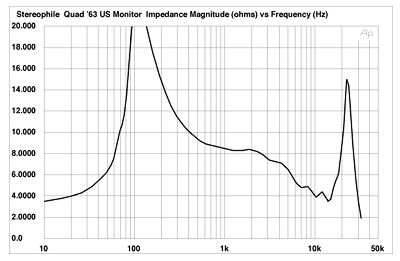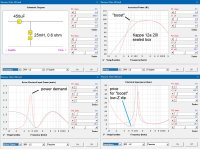Take a look at reviews of "8" Ohm loudspeakers.
Most impedance graphs show impedance dipping down to 5 or even 4 Ohms in the bass regions.
Put in the definitive Telarc recording of the 1812 Overture, turn the volume up to max, and hang on all the way to when the real cannon is shot . . .
6Hz, where loudspeaker Z = DCR.
When RCA made the late 1950s recording of the 1812 Overture, they had the monitor speakers turned up too high.
The woofer cones jumped out of the speaker baskets!
Recording engineers, and overzealous listeners beware:
Turn the volume down!
Most impedance graphs show impedance dipping down to 5 or even 4 Ohms in the bass regions.
Put in the definitive Telarc recording of the 1812 Overture, turn the volume up to max, and hang on all the way to when the real cannon is shot . . .
6Hz, where loudspeaker Z = DCR.
When RCA made the late 1950s recording of the 1812 Overture, they had the monitor speakers turned up too high.
The woofer cones jumped out of the speaker baskets!
Recording engineers, and overzealous listeners beware:
Turn the volume down!
Wonderful benchmark recording. I have it on SACD.Put in the definitive Telarc recording of the 1812 Overture, turn the volume up to max, and hang on all the way to when the real cannon is shot . . .
Angry Fat Cat,
1 Ohm at 20kHz?
Yes, some Electrostatic speakers.
Usually capacitive reactance, which drives some global negative fed-back amplifiers into oscillation.
If your amplifier has to put out lots of power at 20kHz, then . . .
Your tweeter will die
Your ear's high frequency response will die
You are not listening to real music. Real music does not have high amplitude harmonics at 20kHz.
Just my opinions
1 Ohm at 20kHz?
Yes, some Electrostatic speakers.
Usually capacitive reactance, which drives some global negative fed-back amplifiers into oscillation.
If your amplifier has to put out lots of power at 20kHz, then . . .
Your tweeter will die
Your ear's high frequency response will die
You are not listening to real music. Real music does not have high amplitude harmonics at 20kHz.
Just my opinions
QUAD 63:

Also from Sterophile:
dave

Also from Sterophile:
...it looks as if MartinLogan's specifications of 4 ohms for the ESL 15A's impedance and 0.52 ohm at 20kHz for its minimum magnitude are correct…
dave
What makes it hard is that heat dissipation in all components go with P = I² * R.
Where R is the resistance of each component (in circuit)
So just a little more current and the heat dissipation goes through the roof.
Go image what happens with dynamic peaks.
Which also puts a lot of strain on how much buffer there is available from the capacitors.
Where R is the resistance of each component (in circuit)
So just a little more current and the heat dissipation goes through the roof.
Go image what happens with dynamic peaks.
Which also puts a lot of strain on how much buffer there is available from the capacitors.
I combine a Hiraga 8W with two Final 0.4 ESL's: perfectly fine.... I have simple Hiraga's Class A 20W amp. And I don't have ESL and don't know good it or bad...
(The F0.4 has a dynamic LS for the low freq's - quite a complex Z.)
Just noice that amplifiers with big claims has relative small transformers, given these current demands.But we forgot to ask the opinion of transformer and capacitors in PSU, what they are thinking about this. If 8.25A RMS it will need at least 16.5A transformer.., per channel, I guess.
Amplifiers are no current banks, creating current out of thin air.
Example of such claim: 200W/8Ω & 350W/4Ω. It should be 400W/4Ω (rule of the ideal voltage source), so there is lack of sufficient current already.
What spec @ 2Ω? Even less. It cannot drive... control the load anymore. The amplitude cannot be reached, the feedback drives the amp completely nuts.
That is during peaks with a full generating LS. Hard to measure, unnoticed by most listeners because of lack of 'classic' experience (that cannon again).
I'm trying to design a (modest) 50W/8Ω - 100W/4Ω - 200W/2Ω - 400W/1Ω - 800W/0.5Ω class A amplifier for years now.
Conclusion: scale down to 5W/8Ω (&c) to start with. A full differential inverting Hiraga amp with bridged outputs is the candidate now. Simu's look good.
Not eco friendly though.
The same as 20 kHz is equivalent to: "a certain frequency".And what will you say about 1 ohm on 20 kHz?.. 🤣 🤣 🤣
Difficult loudspeakers and then high power amplifiers: just as useful as tattoos.
Don't forget the long term thermal performance.
A lot of modern amplifiers go totally flat on their face when it comes down to thermals, simply because they can't handle the heat. Although not that much of an issue with home hifi applications maybe.
@Citizen124032
That much power at those low impedance is just insane when it comes down to heat dissipation.
800W @ 0.5 ohm means 40A. For a solid state Class-A amplifier the max efficiency is 25% when not inductively coupled.
So that is wasting an insane amount of energy. Even for a Class-D amp 40A is not easy to handle.
A lot of modern amplifiers go totally flat on their face when it comes down to thermals, simply because they can't handle the heat. Although not that much of an issue with home hifi applications maybe.
@Citizen124032
That much power at those low impedance is just insane when it comes down to heat dissipation.
800W @ 0.5 ohm means 40A. For a solid state Class-A amplifier the max efficiency is 25% when not inductively coupled.
So that is wasting an insane amount of energy. Even for a Class-D amp 40A is not easy to handle.
Hence the scaling down...
But the aim was to build a true voltage source, which proove to be insane devices.
Needed in such an arrangement is some 60A idle current. Given the 50/8 spec, supplies are at +/-30V at least.
That's a heater of 3.6kW - per channel. My wall outlet does not cooperate here.
So far for theory.
But the aim was to build a true voltage source, which proove to be insane devices.
Needed in such an arrangement is some 60A idle current. Given the 50/8 spec, supplies are at +/-30V at least.
That's a heater of 3.6kW - per channel. My wall outlet does not cooperate here.
So far for theory.
6A3sUMMER said:
Put in the definitive Telarc recording of the 1812 Overture, turn the volume up to max, and hang on all the way to when the real cannon is shot . . .
Way back when I was working for the company importing BGW 750 amps into Australia,
they had a listening room that would occasionally host an AEC meeting.
Due to a 'swap & go' policy, there was a repaired '750' being used in this room.
'Some Silly' in the service Dept. (not me) used 2N3773 transistors in repair instead of importing the proper SJ's.
When the 1812 cannon fired > THE AMPLIFIER BLEW ITS BRAINS OUT !
What a catastrophe😵
Put in the definitive Telarc recording of the 1812 Overture, turn the volume up to max, and hang on all the way to when the real cannon is shot . . .
Way back when I was working for the company importing BGW 750 amps into Australia,
they had a listening room that would occasionally host an AEC meeting.
Due to a 'swap & go' policy, there was a repaired '750' being used in this room.
'Some Silly' in the service Dept. (not me) used 2N3773 transistors in repair instead of importing the proper SJ's.
When the 1812 cannon fired > THE AMPLIFIER BLEW ITS BRAINS OUT !
What a catastrophe😵
I've played with "passive" boost filters - look at the brutal load from 450uF series and 25mh/0.6 ohm dcr inductor with a Kappa 12a in a sealed 20 liter box. It could cause a Samson amp to "ratchet" on some drum beats with a little Karlson box (vented)
Attachments
You really want that output inductor aka "Zobel" for this sort of load and a well behaved source. There is no music at 30 kHz+QUAD 63:

Also from Sterophile:
dave
Which is why I used quotes.
The series inductor with parallel resistor found in most class AB amplifiers is a fairly effective protection against electrostatics
The series inductor with parallel resistor found in most class AB amplifiers is a fairly effective protection against electrostatics
- Home
- Amplifiers
- Solid State
- Are very low impedances really that hard to drive?
